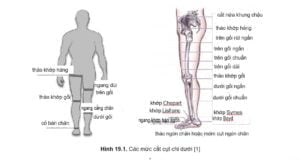Table of contents
OUTLINE
Rehabilitation of patients amputation divided into two training phases: before and during prosthetics. It is essential that the physician address every aspect of the exercise program toward performance goals that are developed by the patient with the support of the rehabilitation technician team. This work is intended to educate the patient about the goals of exercises and activities, and to help motivate the patient to try. Mobility is only one of the functional goals because it also exercises gait,…
ASSESSMENT OF PERFORMANCE PATIENTS
Evaluation is an ongoing process that assesses a patient's physical and functional condition. Evaluate to see if the patient is suitable for prosthetic training and the ultimate goal will be achieved. For accurate evaluation, it is necessary to know how to collect complete data as below steps:
Collect the data
Collect information
- Date and cause of amputation (including amputation surgeries)
- Type of amputation (degree, residual length of limb)

- General health status, medications used and currently taking
- Age of patient
- Anamnesis
Subjective reviews:
- Patient's feelings
Tolerance of loss
Patient's emotional state
- How to live before amputated thread
Patient's level of knowledge and occupation
Family care and support
First time having prosthetic limb
What types of prosthetics have been used?
- When you leave the hospital
Where does the patient live?
How do friends and family help the patient?
Is the accommodation or workplace suitable for amputee patients?
Ability to buy prostheses and replace them
Physical evaluation
- Trunk skin condition
Is the size of the skin area rubbed, scratched, infected?
The status of the location of the scar is blurred
Table 19.1. Evaluation of amputee patients
| Objective | Noteworthy | Recovery content |
| Install prosthetics |
Skin Care Anti-edema Resistant to truncation Limitation of joint range of motion |
Incision care: high footrest. Prevention of joints in bad posture (knee flexion, hip flexion) Bandage the stump properly Move the scar (scarring) to avoid sticking Stretching and moving joints |
| Endurance of the stump |
Skin Care Anti-edema Pain relief |
Increase the tolerance of the stump with pressure Apply hot or cold |
| Prepare for gait training and functional activity |
Muscle weakness Poor endurance Keep balance |
Exercise to strengthen muscles Exercise to increase cardiovascular activity (breathing, sitting up, back arching, chest lift, butt lift, ..) Practice balance while sitting and standing |
| Works without prosthetics |
Joint movement Movement at bed Move |
Exercise with assistive devices or a wheelchair Practice specific functional movements |
- The condition of the skin is healed
PRACTICE PRIOR TO USE PAYMENTS
The focus is on preparing the patient for fitting and training with the prosthesis. Train the patient for maximum independence in the absence of prostheses.
SET OF USE OF CHARGES
Train patients to preserve and use prosthetic limbs in functional activities and gait, even in the working environment, to prepare for social integration. Train the patient to have the stamina to wear a prosthetic for a long time, if the patient is unable to achieve a functional goal without assistance, help as little as possible so that he or she can achieve it. maximum independence.
| Objective | Need attention | Recovery content |
| Install prosthetics |
Deviant gait Pros and cons of prosthetics Limit joint movement |
Introduction of consequences of gait deviation of amputee patients Put on/take off socks Working with prostheses and alternately without wearing Stretching and moving joints |
|
Endurance of the prosthetic limb |
Tolerance of the skin Pain due to prosthetic limb |
Increase time wearing prostheses – Skin care
Ask a doctor, rehabilitation technician and prosthetic manufacturer |
|
Use and care of prosthetic limbs |
Equilibrium Prosthetics |
Instructions on how to remove/install the prosthesis How to take care of the prosthesis Balance while sitting and standing without prosthetics |
| Practice walking | Not strong enough | Continue to exercise |
| Limited endurance |
Exercise to increase cardiovascular endurance – general health Increase walking distance and speed |
|
| Balance |
Maintain balance when sitting, standing with prosthetic limbs. Step enhancement with assist taper |
|
|
The gait is deviated |
Lecture on the consequences of bad gait Use assistive devices at home. Track step length and walking speed |
|
| Walk on a flat surface | Evaluate the longest walk | |
| Walking on the rough road | Practice walking up stairs, rough roads, uphill | |
| Functional activities with prosthetics |
Move Moving objects Living activities Recreational social activities Obstacles at home |
Practice lifting, putting down, taking out and putting objects from the floor Practice carrying, pushing, pulling objects – can use assistive devices Practice dressing, combing hair Depending on the patient's preferences Evaluate household chores, help improve living Offer to provide assistive devices if needed |
ORGANIZATION OF IMPLEMENTATION
Patients with amputation require daily exercise for a relatively long time (3 hours using prosthetics). Exercise groups can be organized into: strengthening exercises, stretching exercises, gait training and functional activities.
Instruct patients in skin care and prosthetics and monitor skin tolerance. Need to be examined once a week. The patient self-monitored the progress and recorded the time of wearing the prosthesis and amputee status on the log.
In the rehabilitation center, local rehabilitation technicians assist patients with home exercises and skin care, amputation, and mobility and function rehabilitation exercises.
EXERCISE TECHNIQUES FOR amputated amputees
Exercises for balance and gait
Stand in the middle double beams (parallel bar) with 2 feet 12m . apart
- Maintain the correct posture, shifting weight from one foot to the other, but the feet do not lift off the ground.
- Do not fold the knee on the right side
- Shifting weight with movement hip joint
- The shoulders and pelvis are kept in a horizontal position.
Standing in front of the mirror, practicing between the double bars
- Place your hands on the double beams on either side of your body
- Alternate mild hip flexion and prosthesis – lift your heel off the floor and try to balance on the prosthesis by grasping and letting go of the bar. When you lose your balance, try to regain your balance.
Practice walking posture (standing in front of the mirror between the double bars)
- Take the prosthesis one short step forward of the good leg.
- Keeping the prosthesis at this point, step forward with the good foot. The healthy foot should step over the prosthesis to transfer weight directly onto the prosthesis.
Bear weight on the good leg, walk back and forth rhythmically with the prosthesis
Hold the prosthesis in one place, bear the load, step back and forth with the good leg, and alternate between the old and weight-bearing good leg
Practice walking sideways towards the normal leg
- Standing on prosthetic legs
- Good foot shape
- Shift body weight onto healthy leg
- Close the prosthesis and place the foot next to the healthy foot
- Repeatedly.
Walk sideways towards the prosthetic
- Standing on normal legs
- Prosthetic legs
- Move body weight to prosthetic leg
- Normal leg closure
- Repeat many times.
Get up from the chair
- Place the healthy foot behind the prosthesis
- Bow down
- Use the prosthesis for balance and stand up with most of your body weight on the normal leg, while extending the prosthesis knee.
Sit down on the chair
- Go to the chair
- Move body weight onto healthy leg
- Rotate the good foot until the back is facing the chair, place the prosthesis next to the good leg
- Slightly bend the prosthetic knee
- Sit down slowly.
These are the basic techniques amputees need to practice to be able to move.
At a more advanced level, the amputee must also practice self-prevention of falls, sitting down and standing up from the floor, going uphill, downhill, going up and down stairs and picking up objects or stepping over an obstacle.
In addition, every day amputees must know how to bandage the stump to install prosthetic limbs.
![Rehabilitation of Amputee Patients 2 Kỹ Thuật Băng Mỏm Cụt Dưới Gối [1]](https://bsvothanhtoan.com/wp-content/uploads/2023/04/Ky-thuat-bang-mom-cut-duoi-goi-1-171x300.png)
![Rehabilitation of 3 . Amputation Patients Kỹ Thuật Băng Mỏm Cụt Trên Gối [1]](https://bsvothanhtoan.com/wp-content/uploads/2023/04/Ky-thuat-bang-mom-cut-tren-goi-1-300x277.png)
ABSTRACT
Rehabilitation for amputee patients is divided into two phases: training before prosthesis and rehabilitation after prosthesis. The goals of rehabilitation are to help the patient move, practice gait, and restore function.
Before developing a rehabilitation program, it is necessary to evaluate the amputee patient to assess whether the patient is suitable for prosthetic training. It is necessary to collect complete and meticulous patient data and assess the physical appearance of the stump, type of stump, skin condition of surgical scars, and types of prostheses used.
Việc tập luyện trước khi dùng chi giả cần chú ý tới việc chăm sóc da chống phù nề, chống joint contracture gần mỏm cụt, tầm vận động khớp, sức bền cơ thể. Cần tập gồng cơ cho khỏe, băng bó mỏm cụt đúng cách cho mỏm cụt có hình thon đúng quy cách, day sẹo tránh dính, tập vận động khớp có tầm hoạt động tối đa, tập thể lực, tập thăng bằng khi ngồi và đứng,… tránh đau khi đã sử dụng chi giả, tập dáng đi, tập lắp chi giả, tập thăng bằng, tập di chuyển, tập sinh hoạt và hoạt động giải trí, tập di chuyển sức nặng chân nọ sang chân kia, tập giữa xà kép, tập đi tới, tập đi ngang, tập đứng dậy khỏi ghế, tập ngồi xuống ghế, phải biết tập băng mỏm cụt dưới gối hoặc trên gối đúng quy cách và tập các tư thế khó như phòng té, tập ngồi xuống đứng lên từ sàn nhà, tập lên dốc xuống dốc, lên xuống cầu thang, nhặt đồ vật hoặc bước qua vật cản.
You have to practice every day and persevere for many hours and days before you can restore mobility and community activities. Rehabilitation physicians and technicians help patients, but the patient's role of perseverance and hard work is crucial to success.



